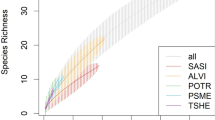Abstract.
Glacier forefronts provide a unique system for studying primary succession of plants and fungi. We constructed a chronosequence of ectomycorrhizal fungus occurrence on the forefront of Lyman Glacier in the North Cascades mountain range in Washington, USA. The plant communities established on non-vegetated substrate as patchily distributed plant individuals and developed towards complex vegetation with a variety of ectomycorrhizal hosts, including Salix commutata, S. phylicifolia, Abies lasiocarpa, Larix lyallii, Pinus contorta, Tsuga mertensiana and additional infrequent taxa. A most probable number assay of non-vegetated substrates over the chronosequence indicated that ectomycorrhizal propagules were few or absent in the non-vegetated areas adjacent to the glacier terminus but increased with time since deglaciation. Ectomycorrhizal fungus sporocarps occurred as soon as the first host plants of substantial size were present. However, none were observed with the most recently established hosts – small A. lasiocarpa seedlings. Only four species (Cortinarius decipiens, C. tenebricus, Inocybe lacera, and Laccaria cf. montana) occurred on substrate deglaciated for less than 40 years. Three of these species (C. tenebricus, I. lacera, and L. cf. montana) occurred along the chronosequence to the terminal moraine on substrate deglaciated for 70–100 years. An additional five species (one unidentified species each of Cortinarius and Lactarius, Cortinarius mutabilis, Lactarius uvidus var. montanus, and Suillus cavipes) occurred only on the oldest substrate. Our results support the current "early- and late-stage" model of ectomycorrhizal fungus succession in that additional species enter the community over time. However, we hypothesize that diversification of the mycorrhizal fungus community in this primary successional habitat resulted from an increasing diversity of host plants along with changing habitat attributes.
Similar content being viewed by others
Author information
Authors and Affiliations
Additional information
Electronic Publication
Rights and permissions
About this article
Cite this article
Jumpponen, A., Trappe, J.M. & Cázares, E. Occurrence of ectomycorrhizal fungi on the forefront of retreating Lyman Glacier (Washington, USA) in relation to time since deglaciation. Mycorrhiza 12, 43–49 (2002). https://doi.org/10.1007/s00572-001-0152-7
Accepted:
Published:
Issue Date:
DOI: https://doi.org/10.1007/s00572-001-0152-7




